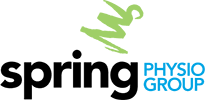Rowing Pre-Season Screening
13 July 2022
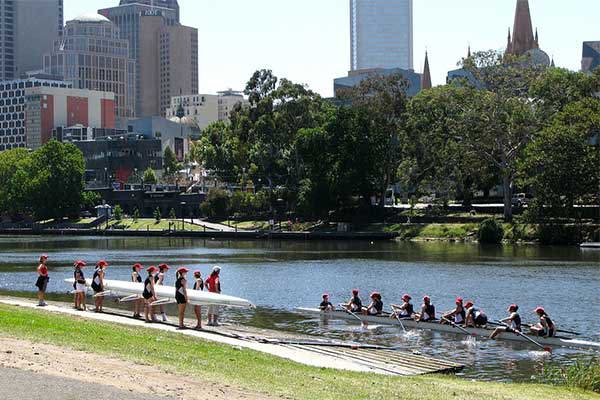
For rowing, just like most sports, it is recommended that athletes undergo a physical screen to identify risk factors for injury. Items a screening test may aim to identify include reduced joint mobility and strength deficits.
We understand rowing places a very unique demand on one’s flexibility and strength and that these demands vary at different phases of the rowing stroke. For example, poor hamstring length can result in poor rock over at the finish making the recovery phase less fluid and ultimately interrupting the momentum of the boat.
The rowing screening tool we use at Spring Physio Group follows recommendations from Rowing Australia, and the specific tests provide us with an insight into your performance in the boat.
Once we have your screening outcomes, our Physiotherapist will provide education to you on the findings, an exercise program to address any unfavourable findings and physiotherapy treatment as needed. Below are a few of the more common issues highlighted in a rowing screen and exercises you can do at home or club to improve testing outcomes.
Knee to wall
Knee to wall is a measure of ankle dorsiflexion (Figure 1). This movement is measured by lunging in front of a wall, foot flat on the floor and observing the distance (in cm) your 1st toe can be from the wall when the knee remains in contact with the wall. The benchmark set for this test is 12cm. Less than 12cm dorsiflexion can compromise an athlete’s ability to achieve full compression at the catch, often athletes compensate by collapsing through their lower back to gain optimal reach as demonstrated in figure 2a and 2b. This can place extra strain on the lumbar spine and increase risk of injury.
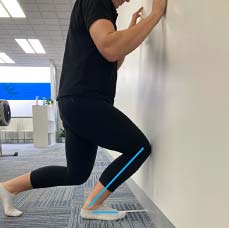 Figure 1: Knee to wall measurement to assess your ankle dorsiflexion
Figure 1: Knee to wall measurement to assess your ankle dorsiflexion
 Figures 2a and 2b: Poor dorsiflexion can compromise an athlete's ability to achieve full compression at the catch.
Figures 2a and 2b: Poor dorsiflexion can compromise an athlete's ability to achieve full compression at the catch.
Practicing a squat in the gym with good technique requires great thoracic (upper back) and ankle mobility (Figure 3). Squats are a great way to achieve improved ankle mobility with the added bonus of improving compression at the hip and knee.
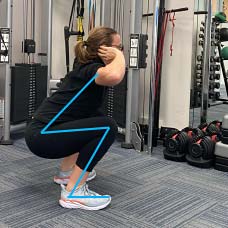 Figure 3: Squat with hands behind head
Figure 3: Squat with hands behind headHip flexion
degree of hip flexion is measured by the angle created between the line of the body and the line of the lateral thigh, the axis is the hip joint (Figure 4). The benchmark for this test is 130. Similar to a lack of ankle dorsiflexion, a lack of hip flexion restricts the athlete’s ability to compress at the catch. Compensatory patterns often involve rounding through the back to achieve optimal reach. The pigeon stretch is a popular way to improve hip flexion mobility by stretching the glutes (figure 5).
 Figure 4: Hip flexion measure lying down
Figure 4: Hip flexion measure lying down
Figure 5: Pigeon stretch
Thoracic rotation
Thoracic rotation is measured in sitting, feet flat on the floor. The athlete then twists to the left and right maximally (figure 6). The angle is measured with a goniometer. The benchmark for this test is 60° rotation.
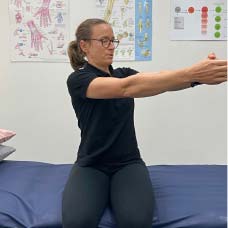 Figure 6: Seated thoracic rotation test
Figure 6: Seated thoracic rotation test
Having an optimal amount of thoracic mobility allows for optimal positioning of the shoulder joint and scapula. Poor load transfer from the oar to the shoulder complex can cause unfavourable compression and shearing forces on the rib cage and lead to chest wall injuries. Improved thoracic mobility also allows the athlete to achieve a more upright position at the catch (figures 7a and b).
 Figures 7a and 7b: Favourable thoracic mobility at the catch.
Figures 7a and 7b: Favourable thoracic mobility at the catch.
 Figures 8a and 8b: Thread the needle exercise for thoracic mobility
Figures 8a and 8b: Thread the needle exercise for thoracic mobility
Sit and reach
Sit and reach is a measure of hamstring flexibility. Athletes sit on the floor, legs stretched out in front. They hinge from the hips and a measurement is taken where their fingertips fall in relation to the toes (Figure 9). The benchmark for this test is fingertips 10cm beyond the toes.
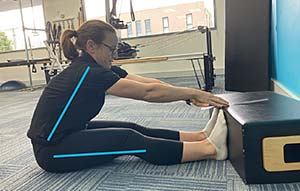 Figure 9: Sit and reach test
Figure 9: Sit and reach test
This test should be performed with a neutral spine, not a flexed spine. Rocking over from the hips at the finish to enter the recovery phase allows the boat to move underneath the athlete. Failing to rock over well can disrupt the flow of the boat and slow its momentum.
 Figure 10a and 10b: The spine should be neutral, not flexed
Figure 10a and 10b: The spine should be neutral, not flexed
Inadequate hamstring length that does not facilitate a good rock over action may look like excessive lumbar flexion at the finish (figure 10a and b). Alternatively, the athlete may not have awareness of how a rock over is performed. Training neuromuscular control and proprioception around this movement can be achieved with a quality hip hinge in the gym (figure 11). As an added bonus, RDL and deadlifts are a great way to actively improved hamstring length (figure 12).
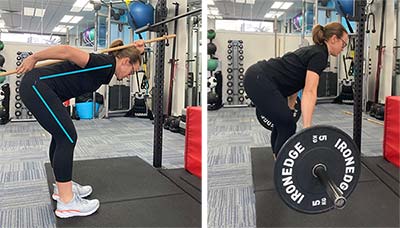 Figure 11: Hip hinge with dowl
Figure 11: Hip hinge with dowl
Figure 12: Romanian deadlift (RDL)
When your physio, sports scientist or coach conduct a screening, results are usually considered good if the benchmark is achieved. If the athlete sits just below the benchmark stretches like the ones above or specific strength exercises can be beneficial.
If the athlete is far from the benchmark or has pain with a particular test they should see their physiotherapist for further assessment. There may also need to be a discussion around rigging to accommodate non-modifiable outcomes.
Our Rowing Australia preferred provider Physiotherapists are here to provide a thorough screening and treatment plan to keep athletes in the boat. We will communicate back to coaches, provide advice and offer insights into solutions, such as modified rigging, to ensure the best outcome for all athletes.
Incorporating a dynamic warm up is a great way to optimise mobility and activate primary muscle groups before on-water and ergo sessions. Rowing Australia has some great resources for dynamic warm ups, please see the link below to check them out.
Mobilise - Warm-Up Essentials (pdf)
Activate - Warm-Up Essentials (pdf)












